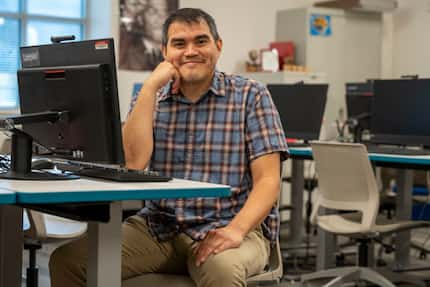The number of Texas children in classrooms led by teachers without a state certification is skyrocketing.
Roughly 1 in 3 new teachers hired across Texas last year were uncertified, meaning the state has no way to know if they received rigorous training. That’s up from 12% in 2019, the year before the COVID-19 pandemic hit.
A Dallas Morning News analysis of statewide hiring data from the 2022-23 school year reveals the extent to which the reliance on uncertified new educators exploded after the pandemic exacerbated teacher shortages across the South.
In North Texas, some districts rely on uncertified teachers more than others. In two dozen school systems — mostly small charters and rural districts — two-thirds or more of new teacher hires were uncertified. Many of those districts were tiny, like Milford ISD, and brought on only a small number of new teachers last year.
“The uncertified teachers — it took them longer to get their feet under them,” said Milford ISD Superintendent Amy Reyna, whose district about 50 miles south of Dallas relied on such educators to fill five vacancies last year.
Across the state, roughly 15,300 new teachers were hired last year without a Texas certification. In 2010, fewer than 2,300 teachers came into the classroom through this pathway.
Charters, which are public schools that have more flexibility in hiring, are primarily responsible for the growth along with a 2015 state law that empowered districts to loosen hiring practices.
The News found rural districts statewide have seen a spike in hiring uncertified teachers in recent years. These schools hired roughly 140 teachers without state certifications in 2010. They had hired nearly 900 last year.
Urban and suburban systems in the area, including Dallas, have a lower overall percentage of uncertified new teacher hires. Within their large workforces, they brought in hundreds of people without state certificates last year.
The state does not publish data that tracks student outcomes by certified vs. non-certified educators.
However, Texas Education Agency leaders have pointed to some reasons for concern.
They know a quality preparation program can give new teachers a leg up in the classroom. But state officials don’t have data on what kind of training uncertified teachers received and, therefore, can’t quantify what level of preparation they have or how intensive it was.
Plus, data shows teachers without a state certification tend to leave the profession at much higher rates.
That increased level of churn is “the piece of the data that is the most concerning for us,” said Kelvey Oeser, a Texas Education Agency deputy commissioner.
During a presentation last spring, state leaders warned superintendents that while hiring non-certified teachers may address short-term recruitment needs, it contributes to long-term retention challenges.
Only 37% of uncertified teachers were still in the public education workforce after five years, a recent state analysis shows. By comparison, 67% of those who took a more traditional route — studying to be a teacher as undergraduates — were still working after five years.
Texas Education commissioner Mike Morath has repeatedly emphasized that teachers are the most important school-based factor affecting student outcomes and that they must be prepared to succeed.
Typically, to become certified in Texas, teaching candidates must have a bachelor’s degree, complete an educator preparation program, pass related exams, submit a state application and go through a background check.
The path to becoming a teacher without state certification is less prescribed.
Some uncertified educators may be switching careers from the corporate world or the military. Others may have worked as teachers in other states and didn’t want to apply for a Texas certification when they moved here. Others could be recent graduates drawn to the classroom amid heavily publicized news about teacher shortages. Their level of training could be wide-ranging.
Quality educator preparation programs are key, researchers say, because teacher candidates must learn how to manage student behavior, plan lessons, serve children with disabilities and other classroom skills.
Rural schools
The Milford school district has struggled to recruit teachers for its nearly 250 students.
Reyna said educators can potentially earn $20,000 more by driving just 20 miles north to work in Waxahachie, a much larger district of about 10,000 students.
A bill that would’ve boosted the pay of small-town educators died during the regular legislative session earlier this year. Lawmakers are debating another attempt to provide rural teachers with bonuses during the third special session, but the proposal’s fate is unclear.
“When we needed them to step up, they didn’t,” Reyna said.
More than one-third of new teachers hired in rural schools last year lacked a state certificate. Like Milford, many schools had a hard time recruiting staff and tend to pay less than schools in urban areas.
Last year, Reyna’s district hired seven new teachers. Five of them were uncertified, according to state data.
Reyna, along with the district’s principal and assistant principal, tried to visit the classrooms of uncertified teachers more often to offer support. They saw the new hires figuring out how to plan lessons and test students. When those assessments revealed gaps, the teachers had to figure out strategies to catch them up.
Among Milford’s new uncertified hires last year was a recent college graduate who was brought in to teach the district’s only third grade class.
By January, she realized teaching wasn’t for her and left. For the rest of the year, the third graders learned alongside fourth graders in a multiage classroom.
“Our state performance of our third graders was not where it had been the year before. We definitely saw that was an impact,” Reyna said. Milford’s fourth grade teacher is now having to fill in her students’ gaps before moving on to grade-level concepts.
Kina Alford said her 9-year-old daughter’s education has been defined by upheaval.
The pandemic hit when Trinity was in kindergarten. She learned virtually in first grade. Her second grade lessons were often taught by substitutes. And last year, she was in the third grade class that lost its uncertified teacher midyear.
“My baby’s been cheated since COVID,” Alford said.
Trinity struggled in a bigger class with the older kids, her mom said. Plus, she did a lot of her classwork in front of a computer screen as the teacher juggled two grade levels.
“She did not like school,” Alford said. “She would cry everyday, ‘I don’t want to go to school.’”
She worries about how the whiplash could impact her daughter later in life, in college. Trinity is a strong reader but fell behind in math, missing out on division lessons.
Alford, who works as Milford ISD’s cafeteria manager, doesn’t blame her superintendent or principal. She knows they’re trying as hard as they can to get students back on track. She wants to see small schools provided more state funding so they can pay toe-to-toe with larger districts.
Reyna said she always tries to hire a certified teacher first. To her, it signals “you have a good understanding of the content that you’re going to be teaching” as well as an awareness of professional responsibilities.
When she needed to turn to uncertified educators, she said she tried to ensure they had a background that would help in the classroom. She asked questions such as: Have you ever worked with kids? Coached Little League? Been a paraprofessional in a classroom?
“There definitely is an extra layer of concern or my wanting to monitor them,” she said.
To attract applicants, Milford ISD decided to cut down to a four-day week this year — a recent trend primarily among small, rural districts. Reyna said it was easier to hire and she found certified teachers to fill most of the open slots. She did hire one uncertified person: A new English teacher studied education, Reyna said, but has yet to pass the test.
Urban schools
Texas school administrators can waive teacher certification requirements by applying for a “District of Innovation” designation. That flexibility, which began with the 2015 law change, is one of the factors driving the spike in uncertified educators.
More than 950 Texas school districts have District of Innovation status. Each school board must pass a plan for how it will use its expanded flexibility, but the state does not approve the plans.
The DOI waiver gave districts a route for hiring career and technical education teachers — professionals who lacked certification but had real-world experience to teach students skills such as plumbing, culinary arts and graphic design.
But districts can also use that flexibility for teaching core subjects.
Major urban districts — such as Dallas — had the lowest percentage of uncertified new hires, at about 17%. That’s still a dramatic increase. The previous year, it was at 7%.
Last school year, Dallas ISD hired roughly 600 new uncertified educators — in a teaching workforce of roughly 10,000. In the previous decade, the district didn’t hire more than 60 uncertified educators each year, state data shows.
Uncertified educators in Dallas ISD get additional training and support during the school year. The district also pairs new hires with mentors to guide them.
“One thing we’ve seen is that what makes a great teacher is having a passion for kids, not having your name on a piece of paper that says you’re certified,” said Robert Abel, DISD’s Human Capital Management chief.
Adrian Zambrano worked as a professional animator before leaving the industry to be a stay-at-home dad. A couple years ago, it was time for him to get back into the workforce.
His wife saw a job posting for a Dallas ISD animation teacher ahead of the 2022 school year.
“That’s great,” Zambrano remembers saying to her. “But I’m not a teacher. I’m not certified or anything.”
His wife urged him on, noting that there was a teacher shortage and Zambrano had years worth of relevant experience. Though the school year had already begun, Zambrano got the job at Molina High School.
Like his students, he grew up in a community with many native Spanish speakers and a high concentration of low-income families. Zambrano tells students he figured out ways to make his dreams come true, and now he’s on campus to show them they could do the same.

“It gave me an opportunity to share my knowledge and experience to students who may not know what kind of careers are out there,” he said.
While Zambrano connected with students, he still had much to learn. Things such as how to translate assignments for Spanish-speaking students. How to accommodate students with special education needs. How to ensure students are focused.
Over the summer, Zambrano worked toward securing his teaching certification. He said the process helped him develop skills for building detailed lesson plans and classroom procedures.
“Without the certification, I’d only be eligible to work here until 2025,” he said. “I figured if I’ve got this new batch of students, and I want to push them all the way through, I’ve got to be here for it.”
While a smaller percentage of urban teachers are likely to be uncertified, the use of such educators gets notice.
Houston ISD, the only Texas district larger than Dallas, was taken over by the state this year because of poor academic performance at a high school. The state-appointed leader, former DISD superintendent Mike Miles, faced backlash from teacher groups earlier this year when he proposed hiring uncertified educators to fill vacancies.
“Lowering the bar to fill vacancies in the classroom is never the answer, in any situation,” Zeph Capo, Texas American Federation of Teachers president, said in a statement. “But lowering the bar to fill vacancies in a district the state took over on the pretense it was not giving students an adequate learning experience? That’s truly astonishing.”
Charter schools
Texas’ charter schools have long had the ability to hire uncertified teachers. These campuses operate with more flexibility than traditional public schools, which advocates say allows them to be more innovative.
In the past several years, charter schools have leaned into certification flexibility more than ever.
Roughly 61% of new charter school hires last year lacked a Texas teaching certificate. That’s up from about one-third in 2010.
At International Leadership of Texas, 70% of new hires last year were uncertified, translating into 314 educators across about 20 campuses.
Charter administrators look for candidates with language experience — locally and abroad — because students at ILTexas learn Spanish and Chinese.
“They’re experienced in education, a lot of them, but from another country or another state,” Laura Carrasco, a deputy superintendent, said.
Carrasco said a teaching certificate essentially boils down to getting good professional development. So at ILTexas, they hold a boot camp for new teachers ahead of the school year with intensive training on lesson plans and managing student behavior.
When classes begin, new teachers have frequent meetings with more experienced educators to build their skills. Teacher teams do regular deep-dives into student data to see how teachers could be better serving specific kids.
Many of the charter’s highest-performing teachers are uncertified, ILTexas officials said.
Charter leaders emphasized that just because someone has a certification, it doesn’t necessarily mean they’re well prepared. There’s been an explosion in online-only certification programs; the largest one in Texas is on probation for failing to prove it fixed a litany of operational problems. State auditors found the company fell short of standards, including failing to demonstrate that its training was based in research.
Still, the charter network puts a premium on certification. ILTexas teachers earn a higher salary if they hold a Texas certificate.
“We recognize that it is an asset to the teacher,” Carrasco said, “and the state values it.”
The DMN Education Lab deepens the coverage and conversation about urgent education issues critical to the future of North Texas.
The DMN Education Lab is a community-funded journalism initiative, with support from Bobby and Lottye Lyle, Communities Foundation of Texas, The Dallas Foundation, Dallas Regional Chamber, Deedie Rose, Garrett and Cecilia Boone, The Meadows Foundation, The Murrell Foundation, Solutions Journalism Network, Southern Methodist University, Sydney Smith Hicks and the University of Texas at Dallas. The Dallas Morning News retains full editorial control of the Education Lab’s journalism.


/cloudfront-us-east-1.images.arcpublishing.com/dmn/TZEIU7FEABEABK3VCJGK374TJI.jpg)
/cloudfront-us-east-1.images.arcpublishing.com/dmn/QHEWKAHAJRFV5HS3KLMMS4V3L4.jpg)
/cloudfront-us-east-1.images.arcpublishing.com/dmn/6XHZI6MSPRKM7DQB7SMNIGAI6Q.jpg)
/cloudfront-us-east-1.images.arcpublishing.com/dmn/FAG2HZD4475SCY5IIQYDG4UXWU.jpg)
:no_upscale()/cloudfront-us-east-1.images.arcpublishing.com/dmn/4E75AOGEYSV3R37DEDNGED76IY.jpg)